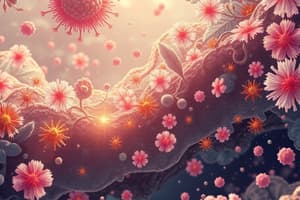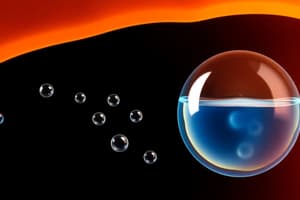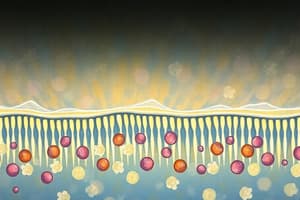Podcast
Questions and Answers
Which of the following statements about diffusion is true? (Select all that apply)
Which of the following statements about diffusion is true? (Select all that apply)
- It requires expenditure of energy by the cell.
- It is a passive process. (correct)
- It always requires integral proteins of the cell membrane.
- It occurs when molecules move from a region of lower concentration to a region of higher concentration.
- It is very rapid over long distances.
Which of the following is a correct difference between active transport and facilitated diffusion?
Which of the following is a correct difference between active transport and facilitated diffusion?
- Facilitated diffusion can move solutes against a concentration gradient, and active transport cannot.
- Active transport can move solutes in either direction across a membrane, but facilitated diffusion can only move in one direction.
- Active transport involves transport proteins, and facilitated diffusion does not.
- Active transport requires energy from ATP, and facilitated diffusion does not. (correct)
- Facilitated diffusion involves transport proteins, and active transport does not.
Which of the following statements about the sodium-potassium pump is correct?
Which of the following statements about the sodium-potassium pump is correct?
- The sodium-potassium pump uses an existing proton gradient to drive the movement of sodium and potassium ions.
- The sodium-potassium pump transports Na+ and K+ across the plasma membrane in the same direction at the expense of ATP hydrolysis.
- The sodium-potassium pump moves sodium out of the cell and co-transports protons into the cell.
- The sodium-potassium pump is a symporter that results in a net negative charge outside the cell.
- The sodium-potassium pump is an antiporter that results in a net negative charge inside the cell. (correct)
Which of the following statements about cotransport of solutes across a membrane is correct?
Which of the following statements about cotransport of solutes across a membrane is correct?
Which of the following enables a cell to pick up and concentrate a specific kind of molecule?
Which of the following enables a cell to pick up and concentrate a specific kind of molecule?
Which of the following categories best describes the function of the rough endoplasmic reticulum?
Which of the following categories best describes the function of the rough endoplasmic reticulum?
Which of the following five membranes is the most likely to have a lipid composition that is distinct from the other four?
Which of the following five membranes is the most likely to have a lipid composition that is distinct from the other four?
Which of the following structures is found in animal cells but NOT plant cells?
Which of the following structures is found in animal cells but NOT plant cells?
At body temperature (37 °C), a very fluid plasma membrane would be composed of primarily?
At body temperature (37 °C), a very fluid plasma membrane would be composed of primarily?
Consider the currently accepted fluid mosaic model of the plasma membrane. Where in the membrane would carbohydrates most likely be found?
Consider the currently accepted fluid mosaic model of the plasma membrane. Where in the membrane would carbohydrates most likely be found?
Which of the following best describes substrate-level phosphorylation?
Which of the following best describes substrate-level phosphorylation?
Which of the following best describes glycolysis?
Which of the following best describes glycolysis?
What best describes oxidation?
What best describes oxidation?
Which of the following is true?
Which of the following is true?
Which of the following must be true of the metabolism of sugar and oxygen into carbon dioxide and water, according to the laws of thermodynamics?
Which of the following must be true of the metabolism of sugar and oxygen into carbon dioxide and water, according to the laws of thermodynamics?
Which of the following is true of glycolysis and the citric acid cycle (oxidative respiration)?
Which of the following is true of glycolysis and the citric acid cycle (oxidative respiration)?
Where are the proteins of the electron transport chain located?
Where are the proteins of the electron transport chain located?
Which of the following best describes the thermodynamic change when sugar and oxygen are reacted to produce carbon dioxide and water?
Which of the following best describes the thermodynamic change when sugar and oxygen are reacted to produce carbon dioxide and water?
Which molecule collects high energy electrons from glucose and transports them around the mitochondria so that they can eventually be given to oxygen?
Which molecule collects high energy electrons from glucose and transports them around the mitochondria so that they can eventually be given to oxygen?
Chemiosmosis uses the energy from the sodium gradient across the mitochondrial membrane to synthesize ATP from ADP and inorganic phosphate.
Chemiosmosis uses the energy from the sodium gradient across the mitochondrial membrane to synthesize ATP from ADP and inorganic phosphate.
What step in photosynthesis produces oxygen?
What step in photosynthesis produces oxygen?
What molecule in the plant leaf is responsible for absorbing light for photosynthesis?
What molecule in the plant leaf is responsible for absorbing light for photosynthesis?
How do chloroplasts generate ATP for use in photosynthesis?
How do chloroplasts generate ATP for use in photosynthesis?
Which step in photosynthesis uses ATP?
Which step in photosynthesis uses ATP?
Where does light absorption occur in a chloroplast?
Where does light absorption occur in a chloroplast?
Flashcards are hidden until you start studying
Study Notes
Diffusion and Membrane Transport
- Diffusion is a passive process that does not require energy, allowing molecules to move from areas of high concentration to low concentration.
- Active transport uses ATP to move molecules against their concentration gradient, whereas facilitated diffusion does not require energy and allows movement with the gradient.
- The sodium-potassium pump actively transports 3 sodium ions out and 2 potassium ions into the cell, creating a net negative charge inside.
Cotransport and Endocytosis
- Cotransport proteins enable multiple solute transports using a pre-established gradient created by ATP-powered pumps.
- Receptor-mediated endocytosis is a process allowing cells to selectively acquire bulk substances through specific receptors on their surface.
Organelles and Membrane Composition
- Rough endoplasmic reticulum is studded with ribosomes to produce proteins that enter the ER lumen or integrate into the membrane.
- Mitochondrial membranes differ in lipid composition due to mitochondrial replication rather than lipid transfer from the ER, unlike most other organelles.
- Centrioles are present in animal cells but absent in plant cells, despite their organized microtubule systems.
Membrane Fluidity and Structure
- At body temperature, fluid plasma membranes are primarily composed of phospholipids with unsaturated hydrocarbon tails, enhancing fluidity.
- In the fluid mosaic model, carbohydrates attached to proteins face outward, forming part of the extracellular matrix.
Metabolic Processes
- Substrate-level phosphorylation is the enzymatic transfer of a phosphate group to ADP, directly generating ATP.
- Glycolysis is a multistep metabolic process transforming glucose, occurring in the cytosol and not directly involving oxidative reactions.
Electron Transport and Energy Transfer
- Oxidation is characterized by the loss of electrons, while reduction is their gain; cellular respiration reactions are essential for energy extraction.
- Glycolysis produces intermediate molecules that are substrates for the citric acid cycle, facilitating further energy production.
Mitochondrial Functions
- Proteins of the electron transport chain are embedded in the mitochondrial inner membrane, crucial for ATP synthesis during oxidative phosphorylation.
- The proton gradient, not sodium, drives ATP synthesis in chemiosmosis during electron transport.
Photosynthesis Mechanisms
- The splitting of water during photosynthesis produces oxygen, while chlorophyll is the pigment responsible for light absorption.
- ATP generation in chloroplasts primarily occurs via the electron transport chain and chemiosmosis during the light-dependent reactions, with the Calvin cycle utilizing ATP for glucose synthesis.
Light Reactions and the Calvin Cycle
- The Calvin cycle uses ATP produced in light reactions to convert glyceraldehyde-3-phosphate into glucose, reinforcing the cyclic nature of photosynthesis.
- Light absorption occurs in the thylakoid membrane of chloroplasts, facilitating the synthesis of ATP and NADPH during the light-dependent phase.
Studying That Suits You
Use AI to generate personalized quizzes and flashcards to suit your learning preferences.




